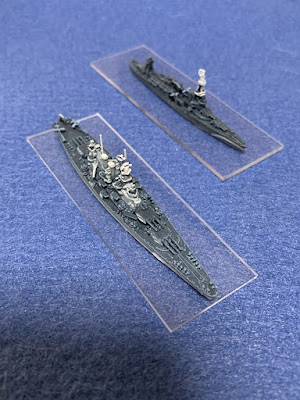Second post in a week! Blogger seems to be less temperamental for me these days, so if this continues I should hopefully find myself posting more often.
I thought I would share one thing I learned this past year; an effective way to make lasting and solid replacements for broken-off bayonets.
Now while I accept that casualties are unavoidable in war, I draw the line at knowingly fielding miniatures with broken bayonets in my units. Some years ago when coming across miniatures whose bayonets had broken off I would have cursed and just binned them, perhaps cannibalizing some for the odd conversion or two.
But given the price of
metal miniatures these days, that’s not something I’m comfortable with
doing any longer.
I was sorting through my (long neglected) Napoleonic Russians from Front Rank and I found that inevitably there were a number of figures whose muskets and bayonets had been bent to breaking, or had even broken off completely, while in storage. A lot of these were older figures, and the metal used was softer than what most manufacturers use today. Having left them jumbled together in bags for some years had taken its toll.
Fortunately, last year I had managed to successfully “rebuild” a missing bayonet on to a Dixon ACW figure. So using the same technique, I saved these from the scrapheap.
I took a dressmaker’s pin, cut it a little longer than the length of the bayonets, and bent a bit near the back end into an “L” shape. Taking a small drill bit the same diameter as the pin, I then carefully drilled a matching hole through the end of the musket.
Before that I had mixed up some of the JB Weld epoxy, leaving it to set up a bit. Then I used the glue to attach the small "L" -shaped part of the pin horizontally into the barrel, and covered both the join and the length of the pin with a good coat of epoxy.
The JB Weld sets slowly, so from time to time I checked it to make sure the new “bayonet” was setting at the correct shape and angle.
Once the glue hardened off, I placed the figures in front of a space heater to cure. Then out came the files and after a bit of work (and taking the sharp point off the pin for safety), I was left with a good, strong join, and a bayonet that will survive the roughest of handling.
The figure on the left has had the pin attached, but it hasn’t yet been filed down into shape. The one in the centre is finished.
The one on the right had it’s musket broken in half where it had already been weakened by a casting flaw. This was an easy matter to fix, again using a small diameter drill to make deep holes through each part, to take a piece of thin brass rod to hold them together using the JB Weld again.
Took less time to do than to describe, and with these three alone, I was able to rescue £4.50’s worth of miniatures at current prices.
The JB Weld has become one of the most useful items in my hobby toolbox. It's a slow-drying epoxy that actually contains metal powder. It comes in two tubes, one white and the other black, and when mixed dries to- you guessed it- a dark grey. It dries as hard as rock, and can be drilled and sanded very easily once it has cured.














































